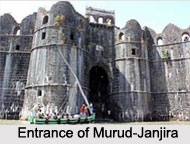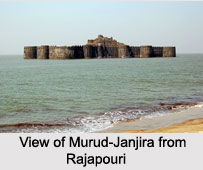 Tourism in Murud-Janjira covers the palaces of intricate Mughal art and architecture, the soldier`s quarter, the mosques and a fresh water lake. Murud-Janjira is an unconquerable island fort in western Indian state. Located in the Raigad District of Maharashtra, Murud-Janjira is popular for the panoramic view of Arabian Sea and Padmadurg that was built by Maratha Empire to give a challenge against Murud- Janjira. Murud-Janjira is now owned by Archaeological Survey of India.
Tourism in Murud-Janjira covers the palaces of intricate Mughal art and architecture, the soldier`s quarter, the mosques and a fresh water lake. Murud-Janjira is an unconquerable island fort in western Indian state. Located in the Raigad District of Maharashtra, Murud-Janjira is popular for the panoramic view of Arabian Sea and Padmadurg that was built by Maratha Empire to give a challenge against Murud- Janjira. Murud-Janjira is now owned by Archaeological Survey of India.
Murud village has the majestic shrines, places of reverence and Nawabi establishments. The erstwhile Siddi tombs with their cryptic passageways, secret lockers and innovative methods overwhelm the tourists while visiting Murud-Janjira.
Panchchaitan Shrine
Panchchaitan Shrine was a seven-storeyed Durbar Hall. At present, this shrine is downed to four levels, due to the lack of maintenance.
Sheesh Mahal
Sheesh Mahal is a ruined fortified palace located inside the Murud- Janjira.
Chirekeni Talav
Chirekeni Talav is a fresh water lake located inside Murud-Janjira.
Jumma Masjid
Inside the fort, there located one mosque, which was once used by the Nawabs of Ahmednagar and Siddi Dynasty. Now the mosque is sill in good condition. Jumma Masjid is located near the lake.
Ahmedganj Palace
Ahmedganj Palace shows the architectural elegance of 19th century. It is a Nawab`s Palace shows an aura of timeless existence. The ceiling of this palace has collapsed in some places, and like a petticoat hem. The wooden rafters have surfaced up the detailing. On the ground level, two spiral staircases rise to the upper floor, which holds the locked rooms of the Nawabs.
Siddi Tombs
Khokri in Murud-Janjira is the final resting place of Sidi Sirul Khan, Sidi Yakut Khan and Sidi Khairiyat Khan, who were the main strong holders of Murud-Janjira. In 1670, Khairiyat had guarded Murud-Janjira when its own general, Fateh Khan, was willing to sell out to Maratha Emperor Shivaji. He fought against the Maratha Empire in 1682 against Shivaji`s successor, Sambhaji. The Siddi tombs have been constructed in the Indo-Saracenic style.
Boating near Murud-Janjira
Murud-Janjira is accessible only by ferry services from Rajapouri. The boat rides from the Rajpuri Jetty takes one to the fort, giving one approximately 30 minutes for exploration.
Visiting Information
Murud-Janjira is reachable only by waterways from Rajapouri. Before that one need to come to Roha which is a nearest railway station. By roadway, one can reach Murud from Mumbai and Pune.



















